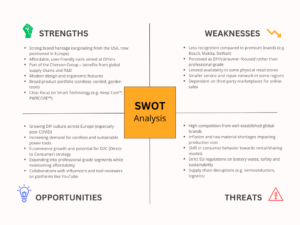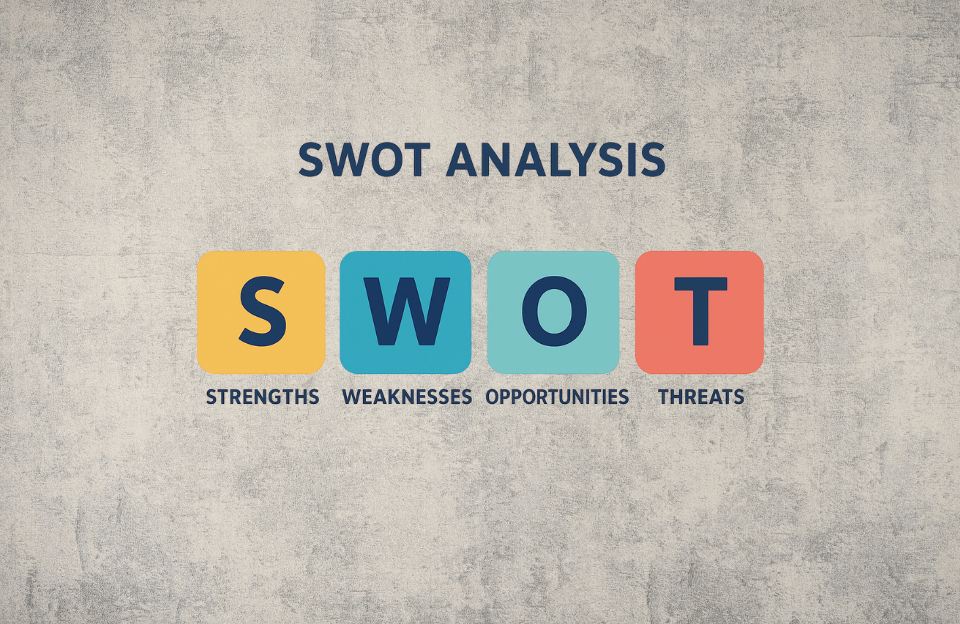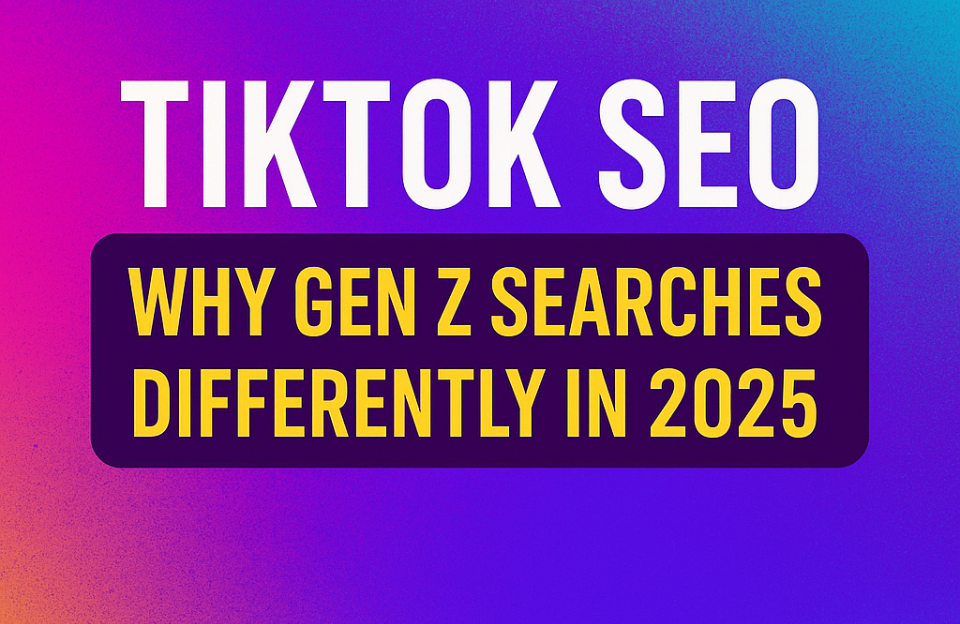In this blog, we’ll break down each element of the framework, illustrate it with real-world marketing examples, and walk you through a structured approach to carry out a robust SWOT analysis for any brand.
Skilleurope.com – SWOT-Analysis Example

1. Strengths: Harnessing Your Internal Advantages 🏆
Definition:
Strengths are internal qualities that give your brand an edge. These include unique resources, existing competencies, and positive brand attributes that set you apart.
Key Areas to Explore:
- Brand equity and reputation
- Proprietary technology or processes
- Skilled marketing teams or agency partnerships
- Existing content, SEO rankings
- Loyal customer base and high customer lifetime value (CLV)
Example – Tech Startup with Niche Expertise:
A SaaS startup specializing in data privacy gained traction by building proprietary encryption features and emphasizing data-led value in communications. Their deep technical expertise became a strength, allowing them to position as a trusted partner in GDPR-compliant marketing.
Marketing Implications:
- Craft case studies around technical wins
- Use strength as a central theme in paid search and content campaigns
- Highlight during pitch decks to investors
2. Weaknesses: Facing Internal Challenges
Definition:
Weaknesses are internal shortcomings that hinder performance, cost money, or block strategy execution.
Typical Weaknesses in Marketing:
- Unclear brand positioning
- Low marketing budget or fragmented budget allocation
- Limited in-house skills (e.g. lack of data analytics, copywriting or paid media expertise)
- Legacy systems that inhibit agility (e.g. outdated CMS, poor CRM integration)
Example – Established Retail Brand with Low Digital Presence:
A long-standing brick-and-mortar store realized their digital footprint was weak after multiple missed campaign benchmarks: low search visibility, slow website, and dated content. They lacked a CRM to capture customer data, resulting in generic email outreach with low engagement.
Marketing Implications:
- Invest in a new CMS and CRM system
- Upskill internal team or hire digital marketer
- Reallocate budget to search engine optimization (SEO) and landing page performance
3. Opportunities: Capitalizing on External Shifts
Definition:
Opportunities represent external trends or untapped niches that could accelerate growth.
Categories of Opportunities:
- Emerging platforms (e.g. TikTok, Clubhouse, podcast advertising)
- New audience segments (e.g. Gen Z, baby boomers embracing tech)
- Technological advancements (AI automation, voice search, augmented reality)
- Regulatory changes (e.g. data protection frameworks)
- Seasonal peaks or global events (Black Friday, World Cup)
Example – D2C Fashion Brand Taps TikTok Trend:
A small direct-to-consumer fashion label noticed interest in sustainable “capsule wardrobes” exploding on TikTok. They leveraged this opportunity, launching a seasonal collection and influencer campaign that achieved 200k video views and 50% sales uplift within the quarter.
Opportunity Radar Tactics:
- Monitor platform analytics and social listening
- Test emerging formats with small-scale pilot campaigns
- Collaborate with niche influencers or micro-creators
- Prioritize opportunities based on fit and ROI potential
4. Threats: Managing External Risks
Definition:
Threats include external forces that can negatively impact your business or marketing strategy.
Common Threats:
- New market entrants or disruptive competitors
- Inflation or economic downturns affecting ad spend
- Regulatory or policy restrictions (e.g. cookie deprecation, ecommerce taxes)
- Platform algorithm changes (e.g. Google core updates, social media feed tweaks)
- Reputation risks (e.g. public backlash, supply chain issues)
Example – SaaS Against Emerging Competition:
A B2B SaaS provider noticed a surge of competitors offering similar low-priced products. Paired with an upcoming Google Ads update, this threat risked both organic and paid visibility. In response, they quickly refined their positioning to emphasize enterprise-grade security and launched webinars to reinforce trust.
Threat-Response Tactics:
- Build “defensive content” (case studies, white papers, FAQs)
- Monitor competitors and market pricing
- Establish diversified marketing channels
- Prepare PR and crisis-response playbooks
5. Step-by-Step: Conducting a Proper SWOT Analysis
- Set a Clear Objective: Align SWOT with a specific goal—e.g. product launch, annual planning, market expansion.
- Gather Data: Audit internal processes, marketing performance, customer feedback, financial results.
- Brainstorm With Stakeholders: Involve marketing, sales, product, finance, and customer success to gather diverse insights.
- Categorize Insights: Place each observation in Strengths, Weaknesses, Opportunities, or Threats.
- Prioritize by Impact and Urgency: Score items based on business impact and ease of implementation.
- Develop Tactical Action Plans: For each priority, define next steps, owners, deadlines, and metrics.
- Integrate Into Strategic Planning: Use SWOT insights in annual plans, roadmaps, or dashboards.
6. SWOT Matrix: Turning Analysis into Action
| Internal × External Combo | Strategy Example | Real-World Tactic |
|---|---|---|
| Strength × Opportunity | Leverage strength in product design + rising consumer demand | Launch a lead-gen campaign showcasing unique features powered by influencer demos |
| Strength × Threat | Use strength to counter competitive threats | Emphasize your IP and security credentials vs low-cost new entrants |
| Weakness × Opportunity | Fix internal gaps to take advantage of trends | Upgrade tech stack to enable personalization and AI marketing |
| Weakness × Threat | Mitigate internal risk to avoid exposure | Re-train staff, outsource specialized ads to reduce ad-platform volatility impact |
Example Strategy:
Our D2C fashion brand found strength in their design team and saw opportunity in micro-influencers. They pressed ahead with a micro-influencer campaign (Strength × Opportunity). Simultaneously, they recognized their weakness in logistics and old web infrastructure—threatened by growing eCommerce competition—so they invested in a new platform and shipping service (Weakness × Threat).
7. Measuring Success: KPIs and Review Process
Key Metrics to Track:
- Website traffic and bounce rate
- Conversion rate uplift
- Customer acquisition cost (CPC, CPA)
- Customer retention, CLV uplift
- Brand sentiment and share of voice
Ongoing Review:
Revisit SWOT quarterly. Ask: Which strengths did we leverage? Which threats materialized? Are there new opportunities or weaknesses emerging?
8. Real-World Mini Case Study: Niche Software Launch
Context:
A productivity tool aimed at remote teams.
SWOT Highlights:
- Strengths: Agile development, engaged email list, active blog
- Weaknesses: Low brand awareness, no paid ad experience
- Opportunities: Rising remote team market post-pandemic, partnerships with coworking platforms
- Threats: Established competitors with venture funding
Strategic Actions:
- Build a webinar series on “remote productivity tips” leveraging blog and email assets. (S × O)
- Outsource Google/Facebook campaign management to specialist agency. (W × O)
- Launch PR campaign targeting tech publications to pre-empt competitor noise. (S × T and W × T)
Results (in 6 months):
- 3× more leads from webinars
- 40% decrease in cost-per-acquisition due to agency optimization
- Backlinks and media coverage from top tech outlets
8. Real-World Case Study: Launching a Niche Productivity Tool for Remote Teams
Context:
A small SaaS startup has developed a lightweight productivity tool designed specifically for remote teams working across time zones. The product emphasizes asynchronous collaboration, task transparency, and minimalist UX. With a lean team of 6, the company is preparing to launch the tool in a market saturated by heavyweights like Asana, Trello, and Monday.com.
The company is bootstrapped, has an active blog and a modest but loyal email subscriber base built through early access signups and content marketing. However, it lacks experience with paid advertising and has minimal brand recognition outside its niche.
SWOT Analysis
Strengths (S)
- Agile development team able to ship new features quickly based on feedback.
- Engaged email list (~4,000 subscribers) with high open and click-through rates.
- Well-maintained blog with SEO-optimized articles on remote work and productivity.
- Founder recognized as a thought leader in the remote work space.
Weaknesses (W)
- Low brand awareness in a competitive productivity tool landscape.
- Lack of in-house experience with paid advertising platforms.
- Bootstrapped budget limits scalability and experimentation.
- Limited social proof at launch (few testimonials or case studies).
Opportunities (O)
- Growing market for remote work tools post-pandemic.
- Potential co-marketing partnerships with coworking platforms and remote communities.
- Increased demand for educational content about hybrid collaboration.
- Rising influence of remote work creators and consultants.
Threats (T)
- Established competitors like ClickUp and Notion with larger budgets and ecosystems.
- Freemium pricing models driving price sensitivity.
- Risk of feature replication by larger platforms.
- Algorithm dependence for organic traffic.
Strategic Actions
(S × O) Leverage Internal Content Strengths
- Developed a six-part webinar series titled “Mastering Remote Productivity,” promoted via the blog and email list.
- Expanded newsletter with curated content and partner productivity tools.
(W × O) Outsource to Fill Gaps
- Partnered with a performance marketing agency to run Google and LinkedIn campaigns.
- Conducted landing page A/B tests to improve conversion rates.
(S × T and W × T) Pre-Emptive Brand Defense
- Launched a 3-month PR campaign targeting mid-tier tech publications and newsletters.
- Positioned founder as a guest expert in podcasts and blog articles related to remote work.
Measured Results (after 6 months)
| KPI | Before Launch | After 6 Months | Δ Change |
|---|---|---|---|
| Monthly Leads | ~120 | ~360 | ▲ 3× |
| CPA (Paid Channels) | N/A | ↓ 40% | ▲ Optimization |
| Email List | 4,000 | 7,800 | ▲ +95% |
| Domain Backlinks | 37 | 121 | ▲ +227% |
| Media Mentions | 0 | 11 | ▲ Exposure |
| Trial → Paid Conversion | 4.8% | 7.2% | ▲ +50% |
Key Takeaways
- Repurposing content into webinars created high-impact, low-cost lead generation.
- Outsourcing weak points accelerated growth while staying lean.
- Thought leadership and PR helped build brand credibility in a crowded market.
Conclusion
A well-executed SWOT analysis is more than just a diagram—it’s a roadmap. For marketers, it’s the strategic tool that transforms insights into action: enabling campaign relevance, budget efficiency, and resilience against disruption.
By systematically identifying your internal strengths and weaknesses, spotting external opportunities, and guarding against threats, you don’t just react—you lead.




